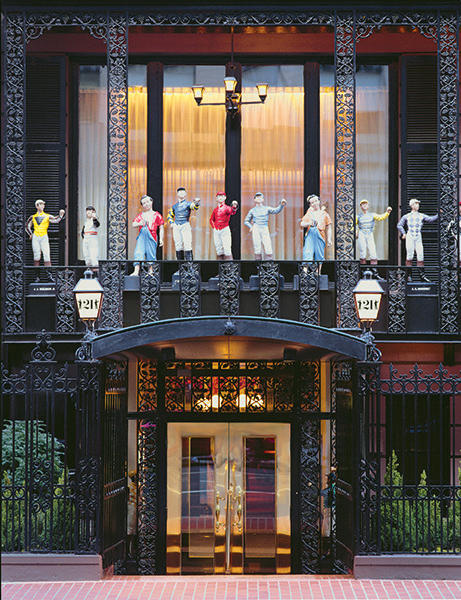
For so long The Street’s survivor

By Megan McKinney
The rumor shot around town at the end of last week: Was it possible that New York’s “21” would close permanently? Then NBC News quoted a “21” spokesperson, “In light of the ongoing global crisis…the difficult decision was made that it will not be feasible to reopen the ‘21’ Club in its current form for the foreseeable future.” But there was also a hint of “exploring potential opportunities” that would allow it to remain a “viable operation.”

The restaurant closed last spring on March 16, yet, like so many others which shuttered at about that time, it appeared to be temporary. Then CNN joined in last week: “Bill Granfield, president of the UNITE HERE Local 100 labor union, (said) he received a letter on December 9 stating the restaurant is closing and all employees will be permanently terminated on March 9, 2021.”

So empty. So sad. However, let’s not be too quick in counting the great restaurant out. Twice in its long history “21” has first survived and then flourished while all competition was falling away.
It all began during Prohibition, with the future “21” Club operating as a fashionable upmarket speakeasy under various names and at several addresses before Jack Kriendler and Charlie Berns anchored the developing legend at 21 West 52nd St. in January 1930–90 years ago!

Meanwhile, a future rival, the Stork Club, had been established on West 58th St. the year before by former bootlegger Sherman Billingsley. After the Stork was raided by Prohibition agents in 1931, it reopened on East 51st St. for three years and then moved to 3 East 53rd Str., between Fifth and Madison Avenue.

When Prohibition ended in December 1933, there was never a greater occasion for celebration. Nor was there a more congested spot on an opening night than the sidewalk outside 154 East 54th St. when the chic speakeasy, the Bath Club, reopened as El Morocco.

Ava Gardner and Artie Shaw against Elmo’s zebra banquette.
Of the three, “21” was initially the least successful. Possibly it had fallen out of favor because, as a restaurant, it did not offer music and a dance floor. Nor did it have the publicity machines of the Stork Club’s Walter Winchell, who spent every evening there, or El Morocco photographer Jerome Zerbe, whose candids from the night before appeared in the Journal American every afternoon.

In any case, “21” did not experience the immediate post-repeal success of Morocco or the Stork, and owners Jack Kriendler and Charlie Berns came close to bankruptcy during the restaurant’s first year. It was characteristic of these men–who had offered credit, their own scrip and even cash advances to Depression-strapped customers–that they fired no employees and even met the outside offers some received. The resourceful partners recovered by establishing “21” Brands imported whiskey, which they distributed to bars and restaurants throughout the country and, by the mid-1930’s, they were again serving a prestigious clientele, which they have retained.

Prices at “21” have always been notoriously high. But, historically, it has been the city’s power lunch and dining spot, where for decades the prominent and well-to-do have gathered around the club’s red checked tablecloths to eat chicken hash under big-boy toys dangling from the ceiling. For years, the cognoscenti referred to the restaurant as Jack & Charlie’s. And for some, it was “the front porch,” because—like the front porch of Raffles Hotel in Singapore—if you sat there long enough, everybody-who-was-anybody would eventually show up. By 1935, “21” Club was headed toward its glory days.

West of “21”on 52nd Street nearly 40 other former speakeasies were emerging from behind their bolted doors; some reappeared as minor French restaurants, a few were converted into bars or strip joints, but most had become jazz clubs. The one-street belt had resulted from the earlier exodus of wealthy area brownstone owners moving to estates in Connecticut or Long Island, and leaving their former homes to be divided into apartments by developers–developers who had soon found that ground floor units brought significantly higher rents as speakeasies.

Following the Prohibition years of dreary anonymity behind unmarked doors, the block between Fifth and Sixth burst forth as “The Street,” with a gloriously raffish jumble of self-promoting neon lining both sides of the block. Three-story vertical signs dominating the five-floor brownstones to which they clung proclaimed: Onyx, Jimmy Ryan’s, Famous Door, Three Deuces, Spotlite, Yacht Club, Downbeat. The aggressive march of names jumped Sixth Avenue to announce additional now-legendary spots in the next block, including Kelly’s Stable and The Hickory House.

From 1934 until 1950 or so, various garish signboards appeared, vanished and often reappeared in different locations along The Street and, for those few breathtaking years, this energetic sweep flourished as the jazz capital of the world.

As leases fell in and rents mounted along 52nd St., the majority of the great jazz clubs collapsed or moved on. Others, most notably Jimmy Ryan’s and Hickory House, remained for a few years before vanishing forever. Birdland, appeared on Broadway near the corner of 52nd St., and a block south, at 51st, was Basin Street. But everything else was gone.
Surviving all its neighbors on The Street was “21” Club.

Of the three great power clubs emerging from Prohibition, El Morocco, the Stork Club and “21,” only the last survived intact into the mid-60’s. El Morocco was around for a while in various uncertain spots after leaving its iconic 154 East 54th St. address in 1960. Owner John Perona died the following year. The Stork Club closed in 1965 and, like Perona, Sherman Billingsley survived his club by only a year. That was 55 years ago.

Who knows? With a record like that, those empty tables may be filling up again soon.
Edited by Amanda K. O’Brien
Author Photo by Robert F. Carl







